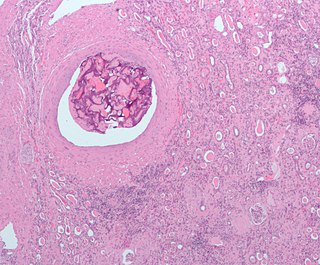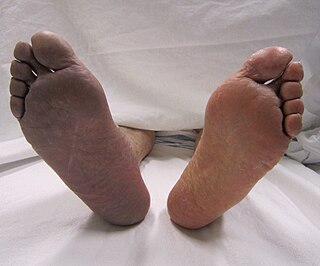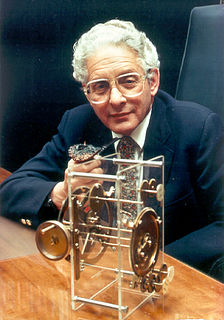
An embolism is the lodging of an embolus, a blockage-causing piece of material, inside a blood vessel. The embolus may be a blood clot (thrombus), a fat globule, a bubble of air or other gas, or foreign material. An embolism can cause partial or total blockage of blood flow in the affected vessel. Such a blockage may affect a part of the body distant from the origin of the embolus. An embolism in which the embolus is a piece of thrombus is called a thromboembolism.

Thrombosis is the formation of a blood clot inside a blood vessel, obstructing the flow of blood through the circulatory system. When a blood vessel is injured, the body uses platelets (thrombocytes) and fibrin to form a blood clot to prevent blood loss. Even when a blood vessel is not injured, blood clots may form in the body under certain conditions. A clot, or a piece of the clot, that breaks free and begins to travel around the body is known as an embolus.

A thrombus, colloquially called a blood clot, is the final product of the blood coagulation step in hemostasis. There are two components to a thrombus: aggregated platelets and red blood cells that form a plug, and a mesh of cross-linked fibrin protein. The substance making up a thrombus is sometimes called cruor. A thrombus is a healthy response to injury intended to prevent bleeding, but can be harmful in thrombosis, when clots obstruct blood flow through healthy blood vessels.

Derek John de Solla Price was a physicist, historian of science, and information scientist, credited as the father of scientometrics.

I Had Trouble in Getting to Solla Sollew is a 1965 children's book by Dr. Seuss. The story features classic Seuss rhymes and drawings in his distinctive pen and ink style.

Sollas is a small crofting township on the northern coast of the island of North Uist, Scotland.

Prof William Johnson Sollas PGS FRS FRSE LLD was a British geologist and anthropologist. After studying at the City of London School, the Royal College of Chemistry and the Royal School of Mines he matriculated to St. John's College, Cambridge, where he was awarded First Class Honours in geology. After some time spent as a University Extension lecturer he became Lecturer in Geology and Zoology at University College, Bristol in 1879, where he stayed until he was offered the post of Professor of Geology at Trinity College, Dublin. In 1897 he was offered the post of Professor of Geology at the University of Oxford, which he accepted.
Lines of Zahn are a characteristic of thrombi that appear particularly when formed in the heart or aorta. They have visible and microscopic alternating layers (laminations) of platelets mixed with fibrin, which appear lighter and darker layers of red blood cells. Their presence implies thrombosis at a site of rapid blood flow that happened before death. In veins or smaller arteries, where flow is not as constant, they are less apparent.

Geodia is a genus of sea sponge belonging to the family Geodiidae. It is the type genus of its taxonomic family.

Tetillidae is a family of marine sponges. Tetillids are more or less spherical sponges which are found commonly in all marine habitats at all depths throughout the world. They are especially common in sedimented habitats. Over a hundred species have been described in ten genera.

Aytoniaceae is a family of liverworts in order Marchantiales.
Stelletta is a genus of sea sponges belonging to the family Ancorinidae.

Cliona is a genus of demosponges in the family Clionaidae. It contains about eighty described species.

Ancorinidae is a family of marine sponges belonging to the order of Tetractinellida.

Cinachyrella is a genus of marine sponges in the family Tetillidae.

Tetractinellida is an order of sea sponges. First described in 1876, this order received a new description in 2012 and replaced the two orders Astrophorida and Spirophorida, which then became sub-orders as Astrophorina and Spirophorina.

Craniella is a genus of marine sponges in the family Tetillidae.
Pachastrellidae is a family of sea sponges.
Geodia hirsuta is a species of sponge in the family Geodiidae. The species is found in the waters of Indonesia and was first described by Sollas in 1886 as Cydonium hirsutum.












